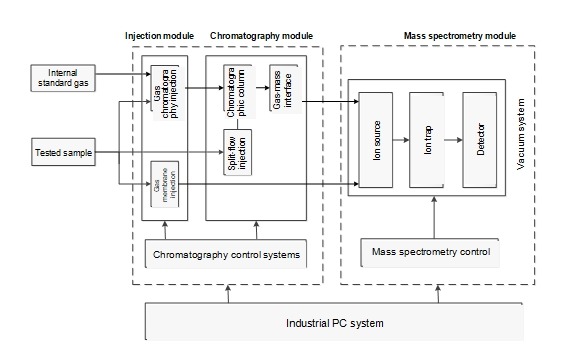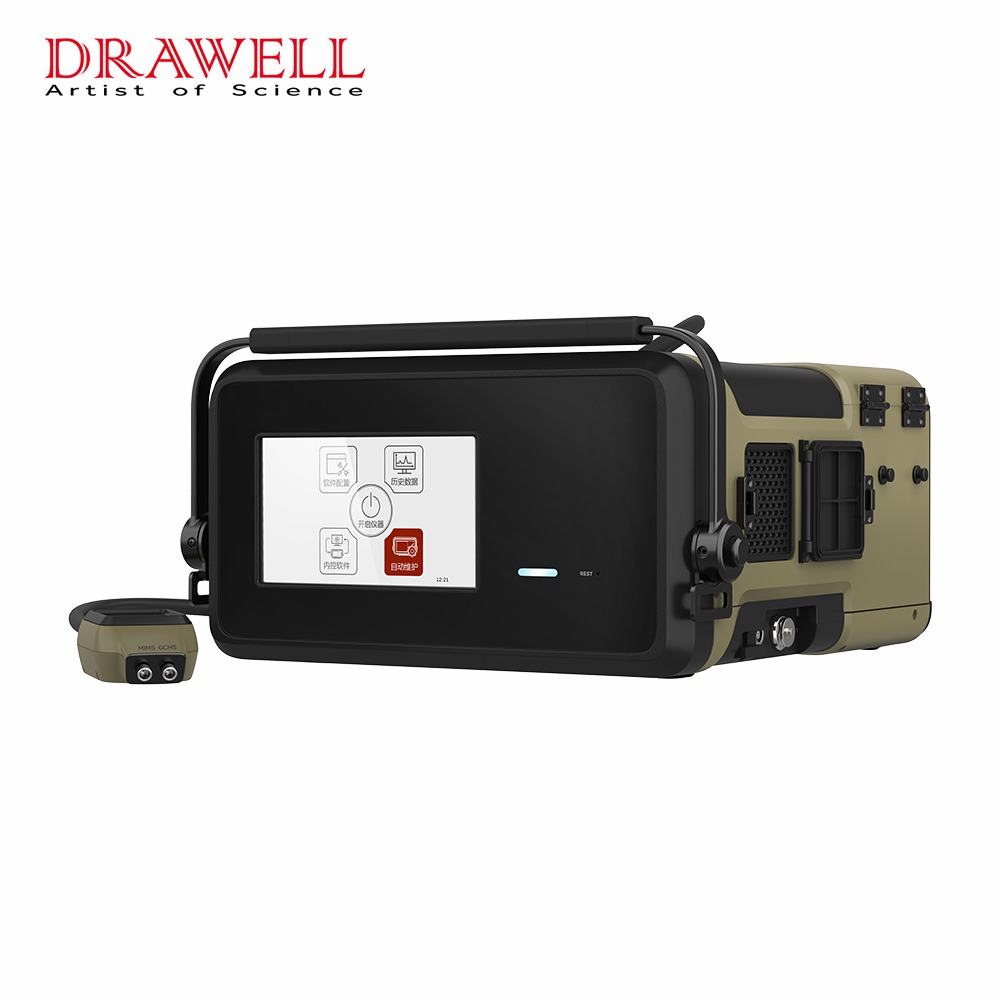Portable GC-MS DW-EXPEC3500S Gas Chromatography-Mass Spectrometer
The DW-EXPEC3500S Portable GC-MS is based on gas chromatography-mass spectrometry (GC-MS) technique for the analysis of organic pollutants in the field. It can be equipped on a mobile carrier for monitoring, or can be moved over the shoulder or handheld to sites that are inaccessible by car for rapid qualitative and quantitative analysis of volatile and semi-volatile organic chemical contaminants.
The DW-EXPEC3500S Portable GC-MS uses a single mass spectrometer membrane injection technique, gas chromatography separation technique and ion trap mass spectrometry technique. After passing through the pre-treatment equipment, the sample is fed through a chromatographic injection system or a membrane injection system and then into a mass analyzer to be tested to obtain the qualitative and quantitative results of the sample.
The DW-EXPEC3500S Portable GC-MS consists of an injection system, a gas chromatography module, a gas-mass interface and a mass spectrometry module. The principle of operation is shown in Figure 1: the sample enters the chromatographic separation module through the injection system, where the sample is separated; the separated sample then enters the mass spectrometry module in turn for analysis, and finally the qualitative and quantitative results are obtained through data processing.

Features of Portable GC-MS DW-EXPEC3500S Gas Chromatography-Mass Spectrometer
As a new portable GC-MS, the DW-EXPEC3500S not only features a stable and reliable instrument with high environmental adaptability, but also has the advantages of fast analysis speed, high sensitivity, high contamination resistance and a wide range of injection methods.
- Fast analysis speed: in addition to the separation efficiency of fast chromatography being 5 times higher than that of conventional chromatography, the membrane injection technique allows the sample to enter the mass spectrometry directly without passing through the chromatography, reducing the response time to seconds, making it very suitable for rapid screening.
- A wide range of testing options: with injection modes such as direct mass spectrometry injection, sorptive thermal desorption injection, quantitative ring injection, headspace injection, needle injection and solid phase microextraction injection, covering all the current sample introduction modes on portable GC-MS applications, it enables fast mass spectrometry with second response, ambient air detection at low concentrations, pollution source detection at high concentrations, VOCs and SVOCs detection in water and soil.
- Environmental adaptability: the instrument can operate at -5°C to 45°C and a low air pressure of 54kPa; it is also waterproof to IP55.
- Easy software operation: intelligent wizard-based operation for sample testing and data analysis, greatly reducing training costs and complexity of field use.
- The ion trap’s unique multi-stage mass spectrometry scan mode: SIS scans and MS/MS scans can be performed on substances of interest, which can greatly increase detection sensitivity and reduce false positives.
Specifications of Portable GC-MS DW-EXPEC3500S Gas Chromatography-Mass Spectrometer
| Performance indexes | Mass range | (15~550) amu | |
| Resolution | Better than 1amu | ||
| Injection mode | Software switchable single mass spectrometry injection, GC-MS internal standard sorbent tube injection, GC-MS internal standard quantitative ring injection | ||
| Scanning mode | Full Scan, Selective Ion Monitoring (SIM) and Secondary Mass Spectrometry (MS/MS) scanning modes are available | ||
| Sensitivity | Single mass spectrometric injection | Toluene (5mg/m3) S/N: ≥10 | |
| GC-MS sorbent tube injection | Toluene (10ppb) S/N: ≥50 | ||
| GC-MS split inlet injection | Octafluoronaphthalene (100 pg/μL): S/N≥15 (272amu) | ||
| Single mass spectrometry response time | Toluene 1 ppm: ≤30s; second response time | ||
| Single mass spectrometry recovery time | Toluene 1 ppm: ≤30s; second recovery to reduce the impact on the next sample | ||
| Dynamic range | 107 | ||
| Ion source | EI source, ionisation energy 70eV | ||
| Detector | Electron multiplier tube | ||
| Quality analyzer | Ion trap mass analyzer | ||
| Main unit weight | ≤20kg (including gas cylinder and battery) | ||
| System volume | 44cm×43cm×22cm | ||
| Anti-vibration grade | Meets the requirements of GJB150.16A-2009 | ||
| Waterproof grade | Meets IP55 | ||
| Vacuum | ≤3000 μTorr | ||
| Automatic tuning | The instrument can be automatically calibrated on the mass axis of the main unit | ||
| Calibration function | The internal standard can be added automatically and in real time during the analysis of the sample to achieve the calibration function of the internal standard. | ||
| Pre-sampling function | Ensure that each analysis is not affected by the dead volume of the sampling line | ||
| Blowback function | Ensure that the residue of the sorbent tube after each analysis does not affect subsequent analyses | ||
| Carrier gas | Helium gas in a carrier gas bottle built into the main unit | ||
| Sampling flow | Sampling flow is controlled electronically and adjustable | ||
| Operating parameters | Power supply | 220VAC±10% / 50HZ, or rechargeable battery | |
| Environmental temperature | -5 to 45°C | ||
| Storage temperature | -20~70°C | ||
| Relative humidity | (0%~95%) RH | ||
| Ambient pressure | May be used in highland areas.54 kPa~101.3 kPa | ||
| External communication | Positioning system | GPS, BeiDou dual-mode system, switchable; real-time positioning of the sample testing site | |
| Communication mode | LAN | ||
| WIFI | |||
| Software | Database | NIST Standard Spectrum Library | |
| Automated mass spectral deconrolution and identification system (AMDIS) | |||
| National Institute for Occupational Safety and Health (NIOSH) Database | |||
| Instrument Specific Spectrum Library for Environmental Samples | |||
| Safety Instructions of Chemicals (SIC) | |||
| Environmental Standards Reference Database | |||
| Data acquisition | Built-in IPC with touch screen human-machine interaction; | ||
| Data processing | Built-in IPC; human-machine interaction: touch screenExternal PC; human-machine interaction: keyboard and mouse | ||








